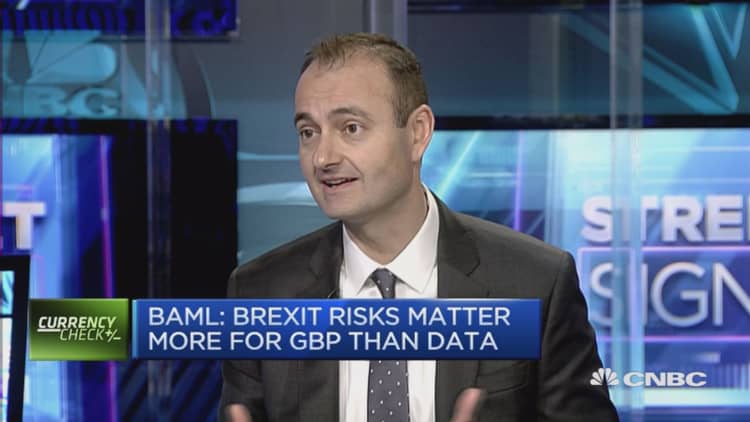The U.K. currency's weakness is set to continue, according to several market watchers, with many suggesting sterling could even reach parity with the U.S. dollar.
Sterling faced a tough time last week, even before a "flash crash" on Friday that sent the currency down almost 6 percent in Asian trade. It has since recovered from this trough, but remains at 31-year lows against the greenback.
"Sterling is trading at an 89-month low on a trade-weighted basis (down 14 percent since the June 23 vote)," said UBS equity strategists in a note on Monday. "UBS expects further weakness and targets for end-2017 are $1.20 for (currently $1.27) and 1.00 for EUR/GBP."
Other experts are more bearish than UBS and have predicted the pound could continue to slip and may reach parity with the dollar in the future.
Macquarie's Nizam Idris suggests sterling could reach parity after the U.K. triggers "Article 50" in March 2017, a motion which kick-starts negotiations to leave the European Union.
"Whether you get to parity or not really depends on how the discussion goes," he told CNBC Monday.
"I think on the trigger of 'Article 50', it will weaken some more."

Other experts include Jeremy Stretch, head of G-10 FX strategy at CIBC Capital Markets, although he said the probability of parity was the "relatively moderate chance" of 1/20.
And while not predicting parity, HSBC's David Bloom said sterling could sink to $1.10 by the end of 2017, according to a new research note on Friday.
One factor driving the possibility of sterling-dollar parity is central bank policy. The U.S. Federal Reserve is expected to raise interest rates again in the near future, while the Bank of England may look to ease monetary policy and cut its benchmark rate further. A higher yielding currency usually leads to more demand, and thus the dollar is expected to strengthen in the months to come.
"Since the start of the period of the U.S. dollar's ascent in mid-2014, the two-year interest rate differential between the U.K. and U.S. government bond markets has widened by more than 100-basis points," said Michael Stanes, investment director at Heartwood Investment Management, in a note.
"This trend may well continue with a Federal Reserve looking to raise interest rates and a Bank of England still in easing mode," he added.
Is sterling weakness a chance to buy?
Tom Elliott, international investment strategist at deVere Group, said investors feared the possibility of a "hard Brexit" – the scenario where the U.K. loses all access to the European single market and customs union – as a main reason for sterling's fall.
"A 'hard Brexit' carries a much greater risk of economic dislocation as investment plans are put on hold by U.K. businesses, and by foreign ones considering investment in the U.K., as they wait to see what tariffs and conditions will apply to U.K./EU trade," he said in a research note.
"A weaker economy usually is bad news for a currency," he added.
But, Elliott also warned investors against knee-jerk reactions to volatility, as the U.K. economy has seen positive data despite the surprise vote in the referendum.
"Doom and gloom forecasters may continue to be proved wrong as a hard Brexit is negotiated," he said.
Thanos Vamvakidis, head of European G-10 FX strategy at BofA Merrill Lynch, echoed Elliott's statement, but warned there were still downside risks for sterling.
"Either the data will weaken or the markets will start focusing on the data in the U.K. and start to buy sterling. I wouldn't try to catch a falling knife, however," he told CNBC Monday.

However, he was optimistic about the currency.
"When you compare sterling with the data, cable (the dollar-pound trade) should be closer to $1.35, rather than $1.25," he added.
"As long as the data remains strong, this is most likely a buying opportunity eventually."


